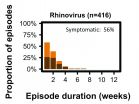(Press-News.org) SALT LAKE CITY - The BIG LoVE (Utah Better Identification of Germs-Longitudinal Viral Epidemiology) study, led by scientists at the University of Utah School of Medicine, finds that each bundle of joy puts the entire household at increased risk for infection with viruses that cause colds, flu, and other respiratory illnesses.
People living in childless households were infected with viruses on average 3-4 weeks during the year. In households with one child, that number jumped to 18 weeks, and for those with six children, there was virus in the household for up to 45 weeks out of the year.
Yet on average only half of those who tested positive for viral infection also had the typical symptoms of coughing, fever, and stuffy nose, an informative finding for both families and their health care providers. The results were published in the journal, Clinical Infectious Diseases.
Kids Fill Hearts With Love, And Homes With Illness
When it comes to explaining why big families have more illnesses, all signs point to young kids as the culprits. Tots younger than five had at least one virus detected in their nasal mucus for 50 percent of the year: twice as often as older children and adults. And when infected, they were 1.5 times more likely to have symptoms, including severe ones like wheezing and fever.
Adding even more stress to a household, young kids didn't suffer alone. Their parents were sick 1.5 times more frequently than similarly aged adults who did not live with young kids.
"A lot families go through wave after wave of illness. In fact, some of the kids we monitored had symptoms for 20 to 25 weeks in a row," says co-first author Carrie Byington, M.D., professor of pediatrics and co-director of the Utah Center for Clinical and Translational Science. "This study helps us to understand what is normal in young children, and can help us determine when illness should be a cause for concern."
It's no secret that children get sick a lot. But BIG LoVE - a year-long survey of a Utah community - is one of the first to use modern diagnostics to track how often kids and other family members, both sick and well, have nasal infections of respiratory virus. Future studies will determine if reported trends hold true in larger and diverse populations.
A Positive Test May Not Mean Positively Sick
Perhaps the most surprising finding was how often participants carried virus, and showed no signs of being sick.
PCR-based diagnostics, like those used to test participants' samples in this study, are becoming increasingly common in clinical settings because they are much more sensitive and accurate than older tests, and provide results within hours, not days. Yet these findings suggest that some test results should be interpreted with caution.
While study participants infected with influenza and parainfluenza viruses were sick most of the time, those who carried rhinovirus - the cause of the common cold - were only sick half of the time.
What's more, results suggest that even after a patient recovers from an illness, some viruses persist for weeks afterward. Bocavirus persisted in the nose for as long as 12 weeks, but more commonly viruses persisted for two weeks or less. In an accompanying commentary also published in Clinical Infectious Diseases, Gregory A. Storch, M.D., of Washington University School of Medicine in St. Louis, noted that the research "provides highly useful information," especially concerning how long PCR-based tests remained positive during each viral episode.
If presence of virus doesn't always translate into illness, then it stands to reason that even if someone is sick and tests positive for a specific virus, there could be another cause. For example bacteria, or a rare virus not detected by the test. Health care providers should be aware of these limitations.
"If a child comes into the emergency room with severe respiratory illness and tests positive for rhinovirus, it might be a smart idea for doctors to make sure they're not missing something else that could be the cause," says co-first author and professor of pediatrics Krow Ampofo, M.B., Ch.B.
How Sickness Was Studied
BIG LoVE was a project to investigate how viruses are transmitted in families. Monitoring a community in Utah, the state with the largest number of children per household, allowed investigators to track differences among big and small families.
Investigators monitored 26 households collectively made up of 108 individuals (three were born during the course of the study) for one year. Each household collected nasal swabs from family members once per week and documented when they had symptoms typical of cold and flu. A PCR-based test, the FilmArray by BioFire Diagnostics, probed swabs for 16 different respiratory viruses, including influenza, rhinovirus, and respiratory syncytial virus (RSV). 4166 samples were analyzed in all. Future studies will examine trends in larger communities, and those in other geographical regions, and of different ethnicities.
INFORMATION:
"Community Surveillance of Respiratory Viruses among Families in the Utah Better Identification of Germs-Longitudinal Viral Epidemiology (BIG-LoVE) Study" was published online in Clinical Infectious Diseases online on August 5, 2015
The work was supported by the National Institutes of Health (NIH), The HA and Edna Benning Presidential Endowment, The Primary Children's Hospital Foundation, the Pediatric Clinical and Translational Scholars Program, and the James S. McDonnell Foundation
In addition to Byington and Ampofo, the authors included Chris Stockmann, MSc, Frederick R. Adler, Ph.D., Amy Herbener, M.D., , Xiaoming Sheng, Ph.D., Anne J. Blaschke, M.D., Ph.D., and Andrew T. Pavia, M.D. from the University of Utah, and Trent Miller and Robert Crisp, Ph.D. from BioFire Diagnostics
CB, AJB, KA, XS, and ATP are investigators on NIH-funded studies in collaboration with BioFire Diagnostics. CB and AJB have intellectual property in and receive royalties from BioFire Diagnostics. ATP has served as a consultant for BioFire Diagnostics. TM and RC were employees of BioFire Diagnostics during the study period
The UK government's current alcohol guidelines are unrealistic and largely ignored because they have little relevance to people's drinking habits, according to a new report by the Sheffield Alcohol Research Group (SARG) in collaboration with the University of Stirling.
The study, the first of its kind, explored how drinkers make sense of the current UK drinking guidelines which suggest men should not regularly exceed 3-4 units of alcohol per day, and women, 2-3 units daily.
Leading researchers from the UK Centre for Tobacco and Alcohol Studies conducted focus groups ...
Researchers from the University of Surrey and Lund University (Sweden) investigated how frequent, long-distance travel is represented in mass and social media. They found that the images portrayed do not take into account the damaging side effects of frequent travel such as jet-lag, deep vein thrombosis, radiation exposure, stress, loneliness and distance from community and family networks.
Instead, the study found that those with 'hypermobile' lifestyles were often seen as having a higher social status. By assessing how first-class flights, 'must-see' destinations and ...
Many mammals, including seals and rats, rely on their whiskers to sense their way through dark environments. Inspired by these animals, scientists working at the University of Illinois at Urbana-Champaign and Illinois' Advanced Digital Sciences Centre in Singapore have developed a robotic 'whisker' tactile sensor array designed to produce tomographic images by measuring fluid flow.
The results are published today (Wednesday 05 August) in the journal Bioinspiration and Biomimetics.
"When it is dark, whiskers play a key role for animals in exploring, hunting or even just ...
Cancer survival in England remains lower than countries with similar healthcare systems, according to a new Cancer Research UK funded study published in the British Journal of Cancer today.
Cancer survival in England has steadily improved but the gap in survival remains.
The research, from the London School of Hygiene & Tropical Medicine, compared survival for colon, breast, lung, ovarian, rectal and stomach cancers in England, Australia, Canada, Denmark, Norway and Sweden between 1995 and 2009, and survival trends in England up to 2012*. It included more than 1.9 million ...
RIVERSIDE, Calif. - Despite their beauty, flowers can pose a grave danger to bees by providing a platform of parasites to visiting bees, a team of researchers has determined.
"Flowers are hotspots for parasite spread between and within pollinator populations," said Peter Graystock, a postdoctoral researcher in the Department of Entomology at the University of California, Riverside and a member of the research team. "Both the flower and bee species play a role in how likely parasite dispersal will occur."
The study, published online in the Proceedings of the Royal Society ...
The price fluctuation of fine wines can now be predicted more accurately using a novel artificial intelligence approach developed by researchers at UCL. The method could be used to help fine wine investors make more informed decisions about their portfolios and encourage non-wine investors to start looking at wine in this manner and hence increase the net trade of wine. It is expected that similar techniques will be used in other 'alternative assets' such as classic cars.
Co-author, Dr Tristan Fletcher, an academic at UCL and founder of quantitative wine asset management ...
This is an observational study so no definitive conclusions can be drawn about cause and effect, but the authors call for more research that may "lead to updated dietary recommendations and development of functional foods."
Previous research has suggested that beneficial effects of spices and their bioactive ingredient, capsaicin, include anti-obesity, antioxidant, anti-inflammation and anticancer properties.
So an international team led by researchers at the Chinese Academy of Medical Sciences examined the association between consumption of spicy foods as part of ...
In the beginning there were four "fundamental" elements besides Hydrogen- not Earth, Air, Fire, or Water, but rather Helium 3, Helium 4, Deuterium and Lithium-7, four "light" isotopes produced by primordial nucleosynthesis (during the Big Bang). The four elements remain, but the calculations simply do not add up. The "metal-poor" stars are celestial bodies composed of mainly primitive material. Based on the Standard Cosmological Model - the most accepted theory today to explain the universe - scientists have calculated how much Li7 should be in them, but the measurements ...
The permanence of memories has long thought to be mediated solely by the production of new proteins. However, new research from the University of Alberta has shown that the electrical activity of the brain may be a more primary factor in memory solidification.
"It's not just protein synthesis, long the dominant biological model, but also 'offline' memory rehearsal in the brain that leads to memory solidification," says Clayton Dickson, psychology professor at the University of Alberta and one of the authors of the new study. "Although the protein synthesis idea is entrenched ...
Case Western Reserve University scientists have discovered that a protein called Kruppel-like Factor 4 (KLF4) controls mitochondria -- the "power plants" in cells that catalyze energy production. Specifically, they determined KLF4's pivotal role through its absence -- that is, the mitochondria malfunction without enough of the protein, which in turn leads to reduced energy. This decline is particularly problematic in the heart because lower energy can lead to heart failure and death.
The researchers' findings appear in the August edition of The Journal of Clinical Investigation ...




